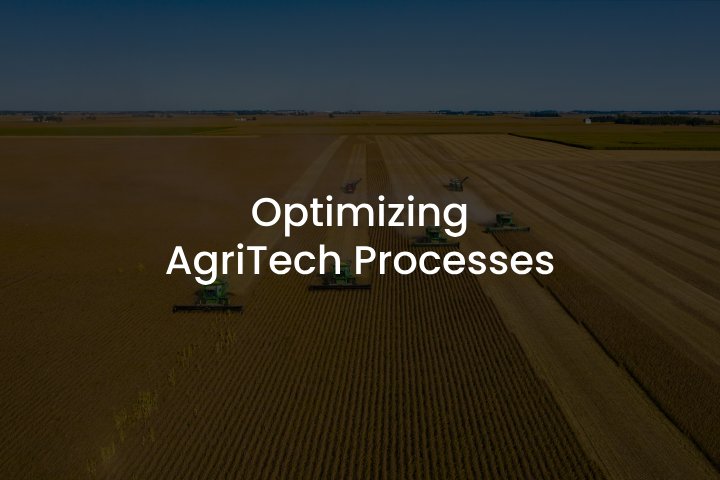
Optimizing AgriTech Processes with Innovative Software Development
The agriculture sector is changing dramatically. Driven by elements like climate change, resource constraints, and a rising world population, agriculture is using technology to become more sustainable, effective, and plentiful. AgriTech here comes in handy.
AgriTech is a broad spectrum of hardware and software programs used to improve farming methods. AgriTech is transforming the way we raise and care for our crops and animals from precision agricultural methods to automated equipment and data-driven analytics.
Traditional AgriTech techniques have one main drawback: they rely on human observation and judgment. Farmers and other agricultural laborers have always depended on their experience and intuition regarding planting, irrigation, pest control, and harvesting. This method, meanwhile, can be arbitrary and prone to mistakes, producing varying results and lost chances for optimization.
Traditional AgriTech Processes and their Limitations
Conventional farming methods have traditionally depended on labor-intensive manual labor, experience-based decision-making, and antiquated technologies. Although this industry has been using these techniques for many generations, they frequently lead to inefficiencies, resource waste, and subpar yields.
The lack of data-driven decision-making in conventional methods presents still another difficulty. Farmers frequently find it difficult to make wise decisions about crop management, resource allocation, and yield optimization without thorough knowledge and analytical tools. Higher costs and environmental impact follow from ineffective use of resources including water, fertilizers, and pesticides brought on by this.
Furthermore, conventional AgriTech techniques sometimes demand time and labor-intensive operations. Manual jobs including harvesting, weeding, and planting call for a lot of human effort that can be physically taxing and prone to human mistakes. This limits the scalability and efficiency of agricultural activities and raises running expenses.
Another major drawback of conventional processes is their lack of automation and precision. Using hand tools for chores including irrigation, fertilizer application, and pest control can produce varying results, waste resources, and environmental issues. Often lacking in conventional AgriTech methods is precision agriculture, the application of technology to maximize input and output while minimizing environmental impact.
Conventional AgriTech systems generally suffer from many constraints including inefficiencies, resource waste, poor yields, and a dearth of data-driven decision-making. The need to optimize these processes using creative software development becomes more important as the demand for food production keeps growing and environmental issues get more urgent.
How Software Development Simplifies AgriTech Systems
Optimizing AgriTech operations depends mostly on innovative software development. Here is the strategy:
- Precision Agriculture: Software provides farmers with real-time information on soil quality, moisture levels, and weather patterns. This maximizes productivity by allowing the exact administration of herbicides, fertilizers, and water—all of which minimize waste.
- Data-Driven Decisions: Sensors and IoT devices gather massive volumes of information on crop and animal health, growth trends, and environmental variables. By use of advanced analytics tools, farmers may understand this data and make well-informed choices about irrigation, resource allocation, and planting.
- Enhanced Resource Management: AgriTech software can optimize water usage by automating irrigation systems and monitoring soil moisture. It may also guarantee effective resource usage and enable monitoring of fertilizer applications.
- Improved Automation: Robotics and automation are changing farm chores. Controlling and administering these technologies depends much on software, which also automates labor-intensive processes including milking, harvesting, and planting.
- Supply Chain Optimization: Software optimizes communication and coordination within the agricultural supply chain. Direct connections between farmers and customers allow them to improve openness and reduce waste through wholesalers.
AgriTech’s Benefits from Leveraging Software Development
AgriTech’s use of creative software development offers several advantages, including:
1. Precision and Personalization in Farming Practices
Precision farming is among the main benefits of using bespoke software solutions in agriculture. Using data analytics, IoT device connectivity, and artificial intelligence-driven insights can help agricultural operations to be precisely matched to the unique requirements of every plot. Automated judgments guided by soil health, micro-climate variables, and crop-specific needs provide optimum input including water, fertilizers, and pesticides. This not only improves productivity and quality but also greatly reduces ecological impact, therefore attesting to the connection between environmental care and technological development.
2. Simplified Operations Efficiency
Using complete Farm Management Systems (FMS) changes agricultural output fundamentally. From crop planning and resource allocation to cattle management and financial monitoring, these complex systems enable the smooth integration of many farm operations. Centralizing data and operational instructions helps stakeholders get real-time insights and make wise choices, lowering manual labor and the margin for mistakes. Moreover, the automation of routine chores releases human resources to concentrate on critical projects, therefore stretching the limits of agricultural innovation.
3. Improved Supply Chain Openness and Responsibility
Ensuring efficiency and confidence in the complex network of agricultural supply chains depends on openness. Blockchain technology-equipped custom software solutions provide unchangeable traceability from farm to table, therefore preserving agricultural product authenticity. Customers are seeking more knowledge about the origin and environmental effects of their food, and AgriTech software development directly addresses this need, therefore enabling a clear, responsible supply chain that supports customer trust and loyalty.
4. Data-Driven Decision Making
It is impossible to overestimate the ability of artificial intelligence and machine learning algorithms to examine enormous volumes of data and derive meaningful insights that could guide behavior. This skill transfers in the context of agriculture to predictive analytics for market demand forecasting, pest control, and crop production. Data-driven insight-equipped decision-makers can foresee difficulties, maximize pricing policies, and guarantee crop variety fits future market trends. Utilizing such analytics, AgriTech companies get a competitive advantage that drives them to lead the front stage in their industry, ready to move with agility and informed confidence.
Looking Ahead: AgriTech Software Development’s Future
Looking ahead to AgriTech software development, AI, IoT, Big Data, and blockchain will be very important in forming sustainable and effective agricultural practices. Combining these technologies promises not only improved agricultural output but also a major contribution to the worldwide issue of sustainable food generation.
Agiliway is dedicated to spearheading the charge in this fascinating field and provides creative, customized solutions addressing the complex problems of contemporary agriculture. Our knowledge and commitment make us reliable allies for companies and decision-makers ready to maximize technology’s possibilities for a better, more efficient future in agriculture.
AgriTech software development is a story of a fundamental change toward a more sustainable and rich future for our global community, not only of technological development. Driving the agricultural sector towards a brighter, more sustainable future through technological excellence and innovation, Agiliway is pleased to be leading the front in this change.


